Western Governors University: Task 1 Organizational Systems Report
VerifiedAdded on 2021/06/15
|6
|1794
|66
Report
AI Summary
This report, prepared for Western Governors University, examines organizational systems and quality leadership within a healthcare context. It begins by defining nursing quality indicators, such as pressure ulcers and patient dissatisfaction, and explains their role in evaluating nursing standards. The report then analyzes a case study involving a patient experiencing a pressure ulcer and receiving the wrong food, highlighting breaches in nursing guidelines and potential ethical violations. It emphasizes how data on nursing quality indicators can identify gaps in care delivery and guide administrators. The report also addresses the resolution of ethical issues, emphasizing the importance of adherence to the ANA Code of Ethics, the implications of negligence, and the need for incident reporting. It discusses legal ramifications of nursing practice, the ethical principles of beneficence, non-maleficence, justice, veracity, and fidelity, and suggests measures to prevent future errors, such as cross-checking patient orders and providing 24/7 supervision for vulnerable patients. The report concludes with a reference list of relevant sources.
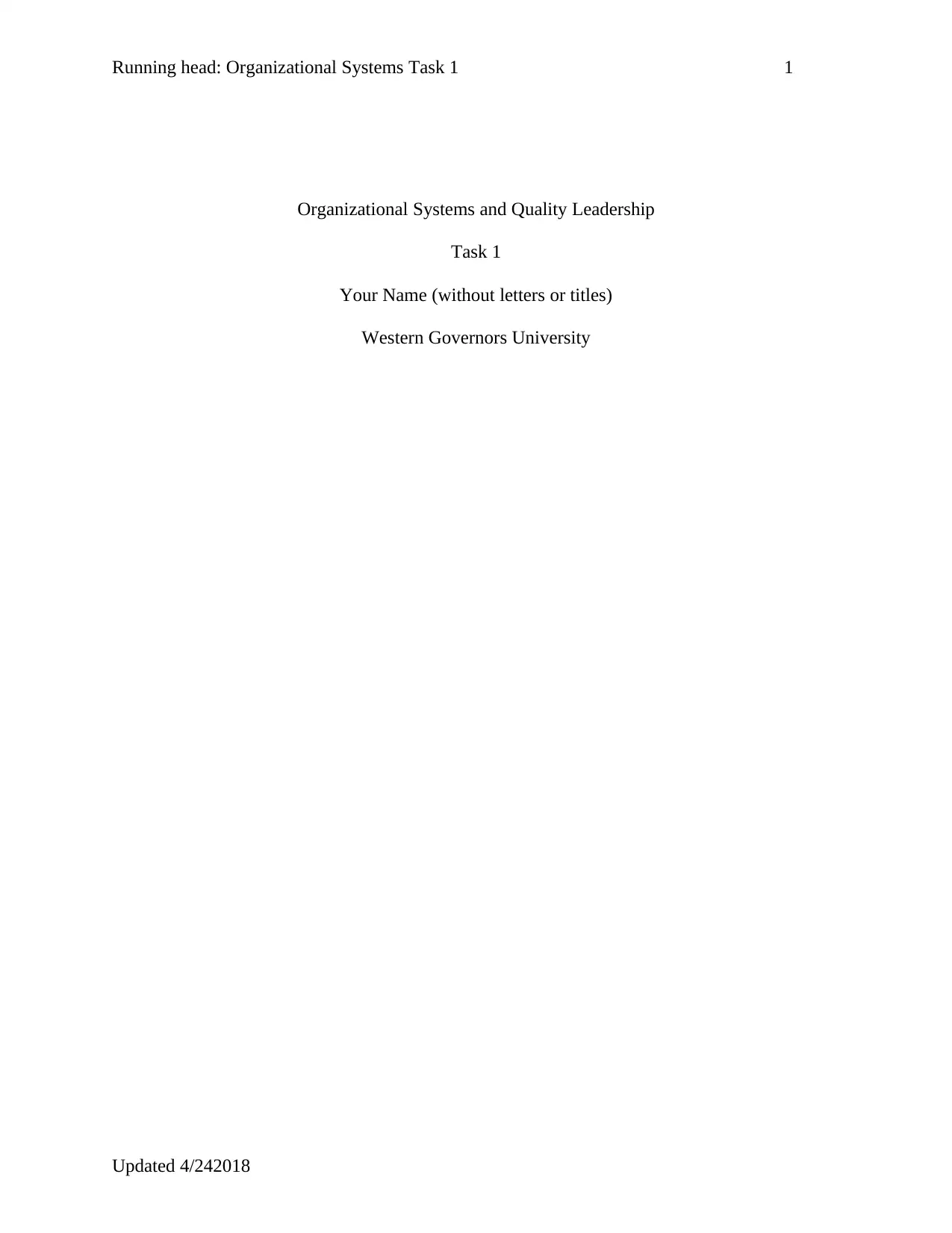
Running head: Organizational Systems Task 1 1
Organizational Systems and Quality Leadership
Task 1
Your Name (without letters or titles)
Western Governors University
Updated 4/242018
Organizational Systems and Quality Leadership
Task 1
Your Name (without letters or titles)
Western Governors University
Updated 4/242018
Paraphrase This Document
Need a fresh take? Get an instant paraphrase of this document with our AI Paraphraser
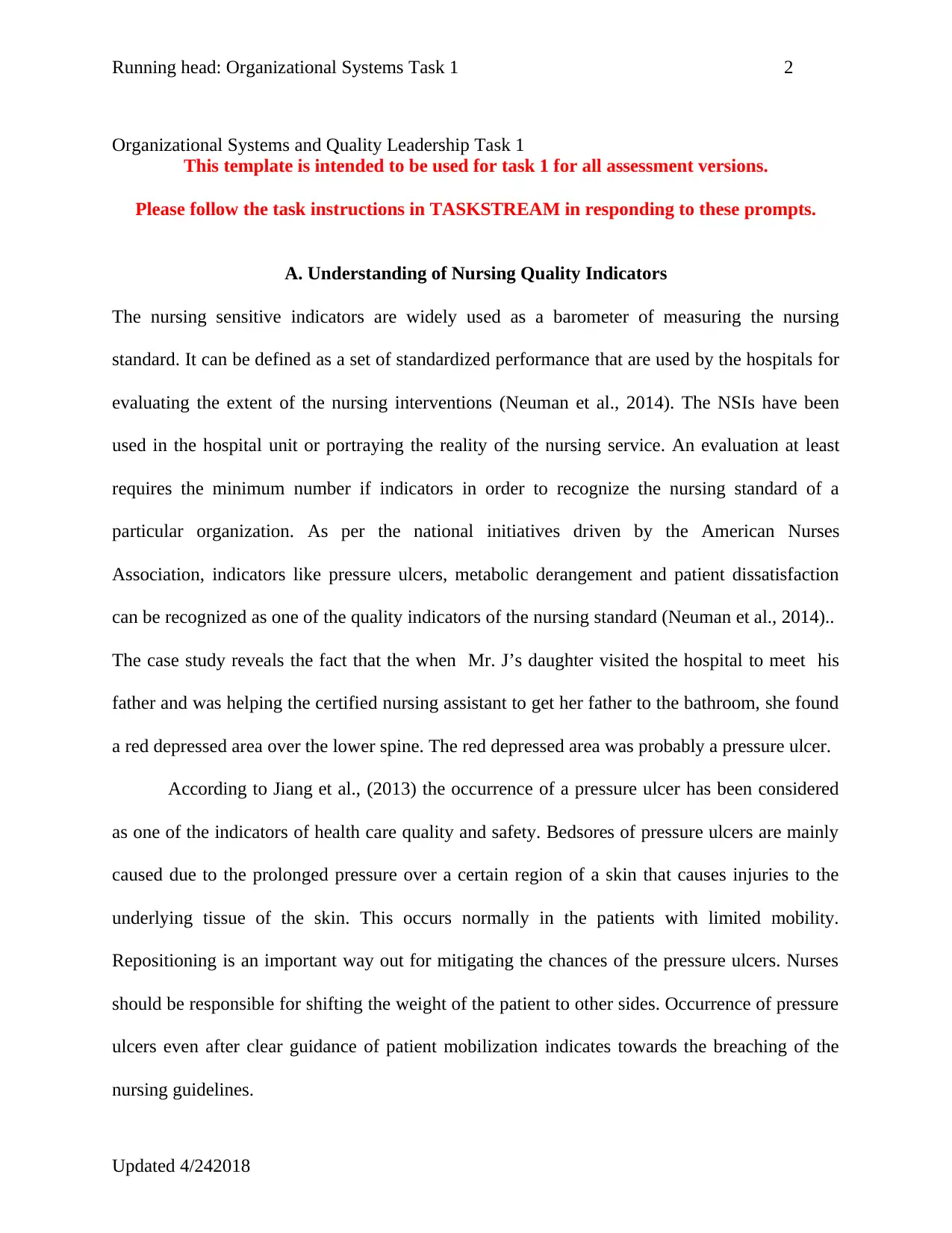
Running head: Organizational Systems Task 1 2
Organizational Systems and Quality Leadership Task 1
This template is intended to be used for task 1 for all assessment versions.
Please follow the task instructions in TASKSTREAM in responding to these prompts.
A. Understanding of Nursing Quality Indicators
The nursing sensitive indicators are widely used as a barometer of measuring the nursing
standard. It can be defined as a set of standardized performance that are used by the hospitals for
evaluating the extent of the nursing interventions (Neuman et al., 2014). The NSIs have been
used in the hospital unit or portraying the reality of the nursing service. An evaluation at least
requires the minimum number if indicators in order to recognize the nursing standard of a
particular organization. As per the national initiatives driven by the American Nurses
Association, indicators like pressure ulcers, metabolic derangement and patient dissatisfaction
can be recognized as one of the quality indicators of the nursing standard (Neuman et al., 2014)..
The case study reveals the fact that the when Mr. J’s daughter visited the hospital to meet his
father and was helping the certified nursing assistant to get her father to the bathroom, she found
a red depressed area over the lower spine. The red depressed area was probably a pressure ulcer.
According to Jiang et al., (2013) the occurrence of a pressure ulcer has been considered
as one of the indicators of health care quality and safety. Bedsores of pressure ulcers are mainly
caused due to the prolonged pressure over a certain region of a skin that causes injuries to the
underlying tissue of the skin. This occurs normally in the patients with limited mobility.
Repositioning is an important way out for mitigating the chances of the pressure ulcers. Nurses
should be responsible for shifting the weight of the patient to other sides. Occurrence of pressure
ulcers even after clear guidance of patient mobilization indicates towards the breaching of the
nursing guidelines.
Updated 4/242018
Organizational Systems and Quality Leadership Task 1
This template is intended to be used for task 1 for all assessment versions.
Please follow the task instructions in TASKSTREAM in responding to these prompts.
A. Understanding of Nursing Quality Indicators
The nursing sensitive indicators are widely used as a barometer of measuring the nursing
standard. It can be defined as a set of standardized performance that are used by the hospitals for
evaluating the extent of the nursing interventions (Neuman et al., 2014). The NSIs have been
used in the hospital unit or portraying the reality of the nursing service. An evaluation at least
requires the minimum number if indicators in order to recognize the nursing standard of a
particular organization. As per the national initiatives driven by the American Nurses
Association, indicators like pressure ulcers, metabolic derangement and patient dissatisfaction
can be recognized as one of the quality indicators of the nursing standard (Neuman et al., 2014)..
The case study reveals the fact that the when Mr. J’s daughter visited the hospital to meet his
father and was helping the certified nursing assistant to get her father to the bathroom, she found
a red depressed area over the lower spine. The red depressed area was probably a pressure ulcer.
According to Jiang et al., (2013) the occurrence of a pressure ulcer has been considered
as one of the indicators of health care quality and safety. Bedsores of pressure ulcers are mainly
caused due to the prolonged pressure over a certain region of a skin that causes injuries to the
underlying tissue of the skin. This occurs normally in the patients with limited mobility.
Repositioning is an important way out for mitigating the chances of the pressure ulcers. Nurses
should be responsible for shifting the weight of the patient to other sides. Occurrence of pressure
ulcers even after clear guidance of patient mobilization indicates towards the breaching of the
nursing guidelines.
Updated 4/242018
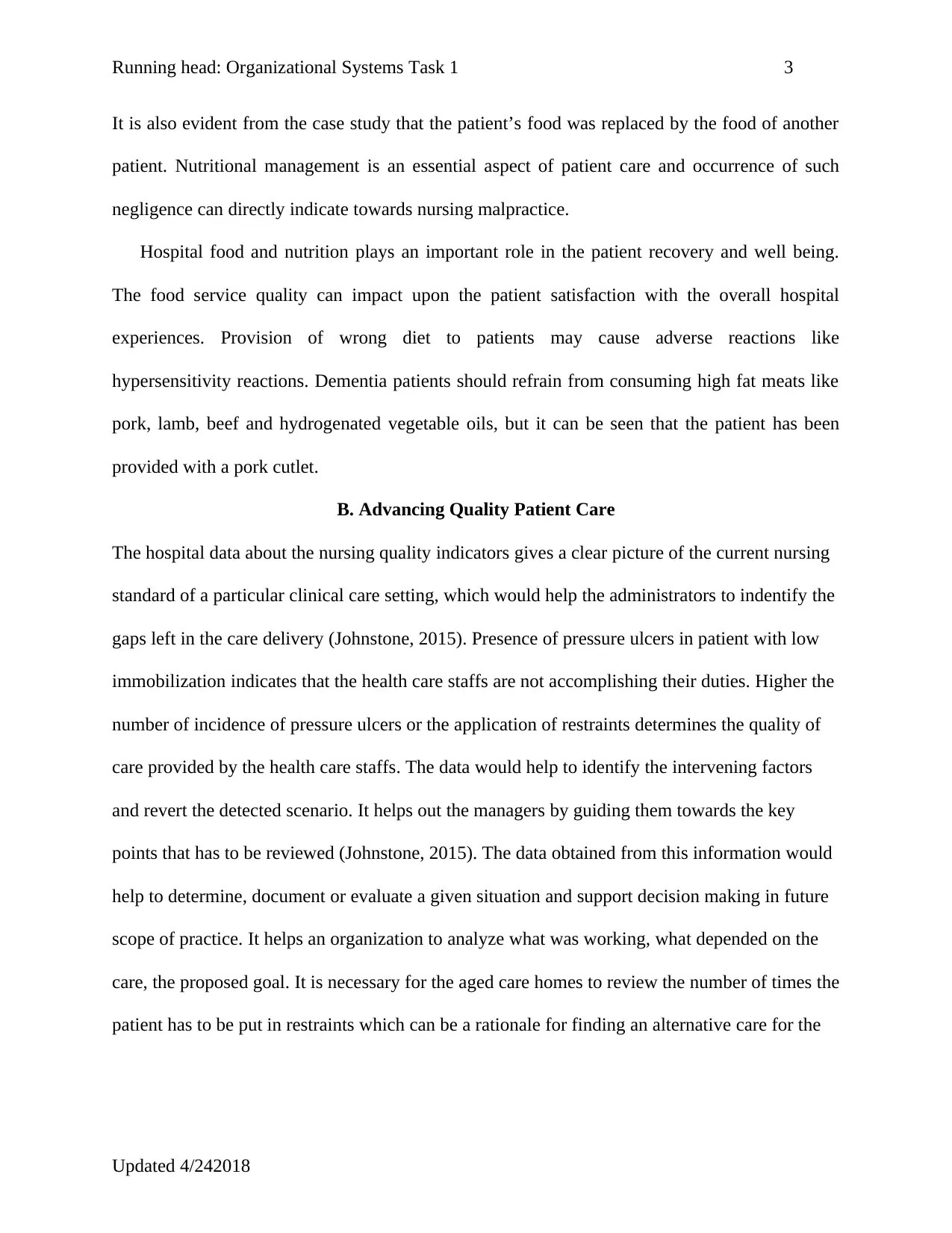
Running head: Organizational Systems Task 1 3
It is also evident from the case study that the patient’s food was replaced by the food of another
patient. Nutritional management is an essential aspect of patient care and occurrence of such
negligence can directly indicate towards nursing malpractice.
Hospital food and nutrition plays an important role in the patient recovery and well being.
The food service quality can impact upon the patient satisfaction with the overall hospital
experiences. Provision of wrong diet to patients may cause adverse reactions like
hypersensitivity reactions. Dementia patients should refrain from consuming high fat meats like
pork, lamb, beef and hydrogenated vegetable oils, but it can be seen that the patient has been
provided with a pork cutlet.
B. Advancing Quality Patient Care
The hospital data about the nursing quality indicators gives a clear picture of the current nursing
standard of a particular clinical care setting, which would help the administrators to indentify the
gaps left in the care delivery (Johnstone, 2015). Presence of pressure ulcers in patient with low
immobilization indicates that the health care staffs are not accomplishing their duties. Higher the
number of incidence of pressure ulcers or the application of restraints determines the quality of
care provided by the health care staffs. The data would help to identify the intervening factors
and revert the detected scenario. It helps out the managers by guiding them towards the key
points that has to be reviewed (Johnstone, 2015). The data obtained from this information would
help to determine, document or evaluate a given situation and support decision making in future
scope of practice. It helps an organization to analyze what was working, what depended on the
care, the proposed goal. It is necessary for the aged care homes to review the number of times the
patient has to be put in restraints which can be a rationale for finding an alternative care for the
Updated 4/242018
It is also evident from the case study that the patient’s food was replaced by the food of another
patient. Nutritional management is an essential aspect of patient care and occurrence of such
negligence can directly indicate towards nursing malpractice.
Hospital food and nutrition plays an important role in the patient recovery and well being.
The food service quality can impact upon the patient satisfaction with the overall hospital
experiences. Provision of wrong diet to patients may cause adverse reactions like
hypersensitivity reactions. Dementia patients should refrain from consuming high fat meats like
pork, lamb, beef and hydrogenated vegetable oils, but it can be seen that the patient has been
provided with a pork cutlet.
B. Advancing Quality Patient Care
The hospital data about the nursing quality indicators gives a clear picture of the current nursing
standard of a particular clinical care setting, which would help the administrators to indentify the
gaps left in the care delivery (Johnstone, 2015). Presence of pressure ulcers in patient with low
immobilization indicates that the health care staffs are not accomplishing their duties. Higher the
number of incidence of pressure ulcers or the application of restraints determines the quality of
care provided by the health care staffs. The data would help to identify the intervening factors
and revert the detected scenario. It helps out the managers by guiding them towards the key
points that has to be reviewed (Johnstone, 2015). The data obtained from this information would
help to determine, document or evaluate a given situation and support decision making in future
scope of practice. It helps an organization to analyze what was working, what depended on the
care, the proposed goal. It is necessary for the aged care homes to review the number of times the
patient has to be put in restraints which can be a rationale for finding an alternative care for the
Updated 4/242018
⊘ This is a preview!⊘
Do you want full access?
Subscribe today to unlock all pages.

Trusted by 1+ million students worldwide
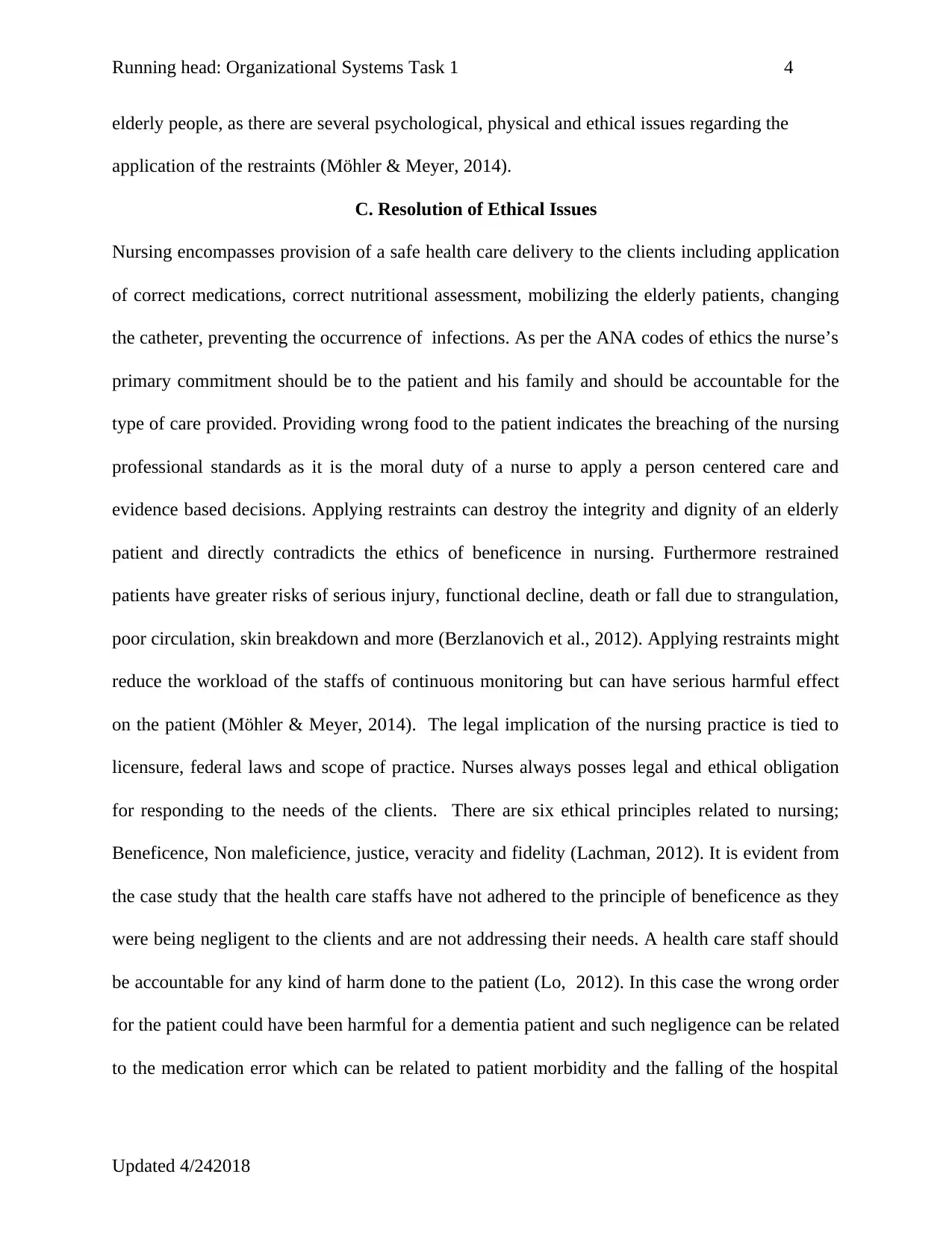
Running head: Organizational Systems Task 1 4
elderly people, as there are several psychological, physical and ethical issues regarding the
application of the restraints (Möhler & Meyer, 2014).
C. Resolution of Ethical Issues
Nursing encompasses provision of a safe health care delivery to the clients including application
of correct medications, correct nutritional assessment, mobilizing the elderly patients, changing
the catheter, preventing the occurrence of infections. As per the ANA codes of ethics the nurse’s
primary commitment should be to the patient and his family and should be accountable for the
type of care provided. Providing wrong food to the patient indicates the breaching of the nursing
professional standards as it is the moral duty of a nurse to apply a person centered care and
evidence based decisions. Applying restraints can destroy the integrity and dignity of an elderly
patient and directly contradicts the ethics of beneficence in nursing. Furthermore restrained
patients have greater risks of serious injury, functional decline, death or fall due to strangulation,
poor circulation, skin breakdown and more (Berzlanovich et al., 2012). Applying restraints might
reduce the workload of the staffs of continuous monitoring but can have serious harmful effect
on the patient (Möhler & Meyer, 2014). The legal implication of the nursing practice is tied to
licensure, federal laws and scope of practice. Nurses always posses legal and ethical obligation
for responding to the needs of the clients. There are six ethical principles related to nursing;
Beneficence, Non maleficience, justice, veracity and fidelity (Lachman, 2012). It is evident from
the case study that the health care staffs have not adhered to the principle of beneficence as they
were being negligent to the clients and are not addressing their needs. A health care staff should
be accountable for any kind of harm done to the patient (Lo, 2012). In this case the wrong order
for the patient could have been harmful for a dementia patient and such negligence can be related
to the medication error which can be related to patient morbidity and the falling of the hospital
Updated 4/242018
elderly people, as there are several psychological, physical and ethical issues regarding the
application of the restraints (Möhler & Meyer, 2014).
C. Resolution of Ethical Issues
Nursing encompasses provision of a safe health care delivery to the clients including application
of correct medications, correct nutritional assessment, mobilizing the elderly patients, changing
the catheter, preventing the occurrence of infections. As per the ANA codes of ethics the nurse’s
primary commitment should be to the patient and his family and should be accountable for the
type of care provided. Providing wrong food to the patient indicates the breaching of the nursing
professional standards as it is the moral duty of a nurse to apply a person centered care and
evidence based decisions. Applying restraints can destroy the integrity and dignity of an elderly
patient and directly contradicts the ethics of beneficence in nursing. Furthermore restrained
patients have greater risks of serious injury, functional decline, death or fall due to strangulation,
poor circulation, skin breakdown and more (Berzlanovich et al., 2012). Applying restraints might
reduce the workload of the staffs of continuous monitoring but can have serious harmful effect
on the patient (Möhler & Meyer, 2014). The legal implication of the nursing practice is tied to
licensure, federal laws and scope of practice. Nurses always posses legal and ethical obligation
for responding to the needs of the clients. There are six ethical principles related to nursing;
Beneficence, Non maleficience, justice, veracity and fidelity (Lachman, 2012). It is evident from
the case study that the health care staffs have not adhered to the principle of beneficence as they
were being negligent to the clients and are not addressing their needs. A health care staff should
be accountable for any kind of harm done to the patient (Lo, 2012). In this case the wrong order
for the patient could have been harmful for a dementia patient and such negligence can be related
to the medication error which can be related to patient morbidity and the falling of the hospital
Updated 4/242018
Paraphrase This Document
Need a fresh take? Get an instant paraphrase of this document with our AI Paraphraser
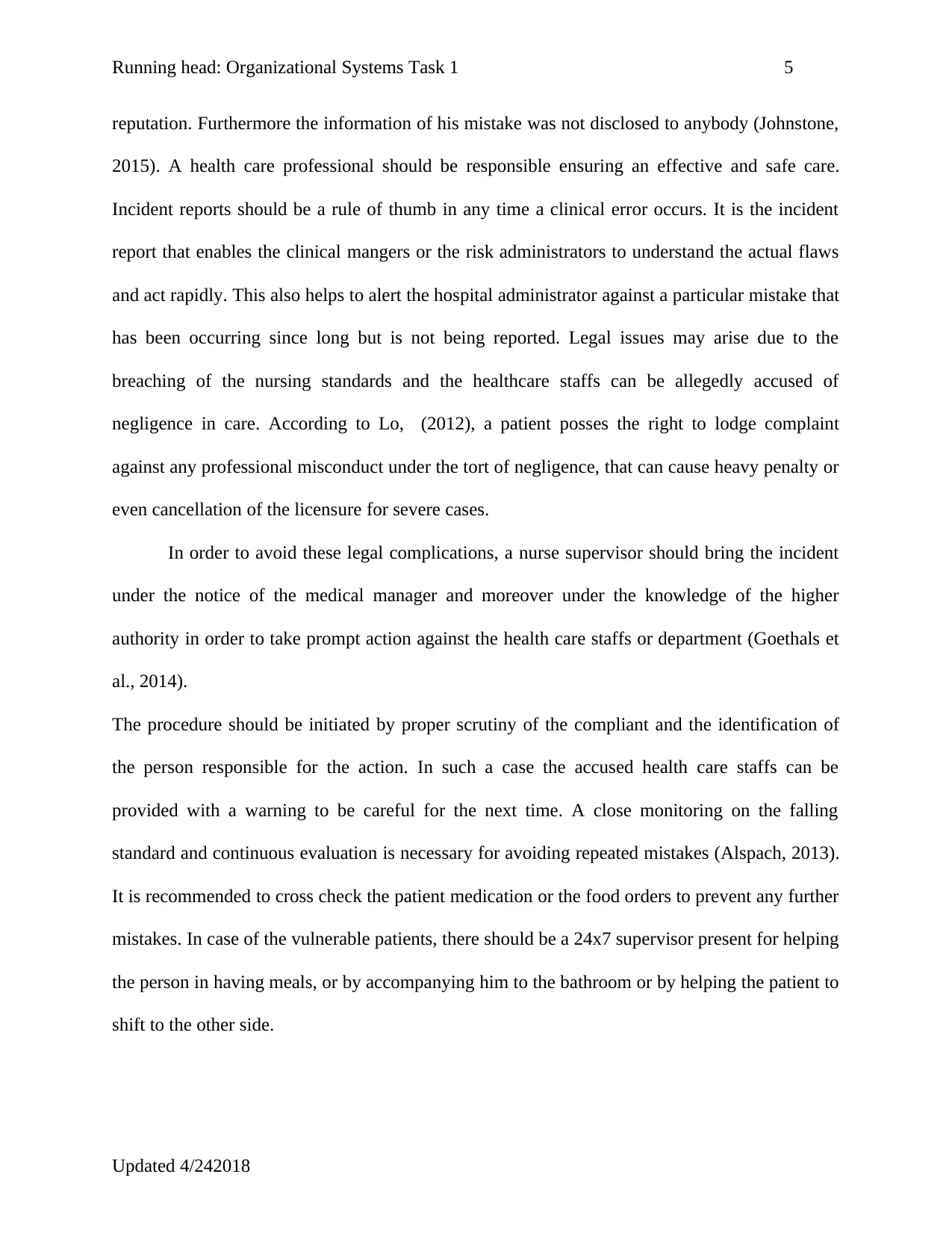
Running head: Organizational Systems Task 1 5
reputation. Furthermore the information of his mistake was not disclosed to anybody (Johnstone,
2015). A health care professional should be responsible ensuring an effective and safe care.
Incident reports should be a rule of thumb in any time a clinical error occurs. It is the incident
report that enables the clinical mangers or the risk administrators to understand the actual flaws
and act rapidly. This also helps to alert the hospital administrator against a particular mistake that
has been occurring since long but is not being reported. Legal issues may arise due to the
breaching of the nursing standards and the healthcare staffs can be allegedly accused of
negligence in care. According to Lo, (2012), a patient posses the right to lodge complaint
against any professional misconduct under the tort of negligence, that can cause heavy penalty or
even cancellation of the licensure for severe cases.
In order to avoid these legal complications, a nurse supervisor should bring the incident
under the notice of the medical manager and moreover under the knowledge of the higher
authority in order to take prompt action against the health care staffs or department (Goethals et
al., 2014).
The procedure should be initiated by proper scrutiny of the compliant and the identification of
the person responsible for the action. In such a case the accused health care staffs can be
provided with a warning to be careful for the next time. A close monitoring on the falling
standard and continuous evaluation is necessary for avoiding repeated mistakes (Alspach, 2013).
It is recommended to cross check the patient medication or the food orders to prevent any further
mistakes. In case of the vulnerable patients, there should be a 24x7 supervisor present for helping
the person in having meals, or by accompanying him to the bathroom or by helping the patient to
shift to the other side.
Updated 4/242018
reputation. Furthermore the information of his mistake was not disclosed to anybody (Johnstone,
2015). A health care professional should be responsible ensuring an effective and safe care.
Incident reports should be a rule of thumb in any time a clinical error occurs. It is the incident
report that enables the clinical mangers or the risk administrators to understand the actual flaws
and act rapidly. This also helps to alert the hospital administrator against a particular mistake that
has been occurring since long but is not being reported. Legal issues may arise due to the
breaching of the nursing standards and the healthcare staffs can be allegedly accused of
negligence in care. According to Lo, (2012), a patient posses the right to lodge complaint
against any professional misconduct under the tort of negligence, that can cause heavy penalty or
even cancellation of the licensure for severe cases.
In order to avoid these legal complications, a nurse supervisor should bring the incident
under the notice of the medical manager and moreover under the knowledge of the higher
authority in order to take prompt action against the health care staffs or department (Goethals et
al., 2014).
The procedure should be initiated by proper scrutiny of the compliant and the identification of
the person responsible for the action. In such a case the accused health care staffs can be
provided with a warning to be careful for the next time. A close monitoring on the falling
standard and continuous evaluation is necessary for avoiding repeated mistakes (Alspach, 2013).
It is recommended to cross check the patient medication or the food orders to prevent any further
mistakes. In case of the vulnerable patients, there should be a 24x7 supervisor present for helping
the person in having meals, or by accompanying him to the bathroom or by helping the patient to
shift to the other side.
Updated 4/242018
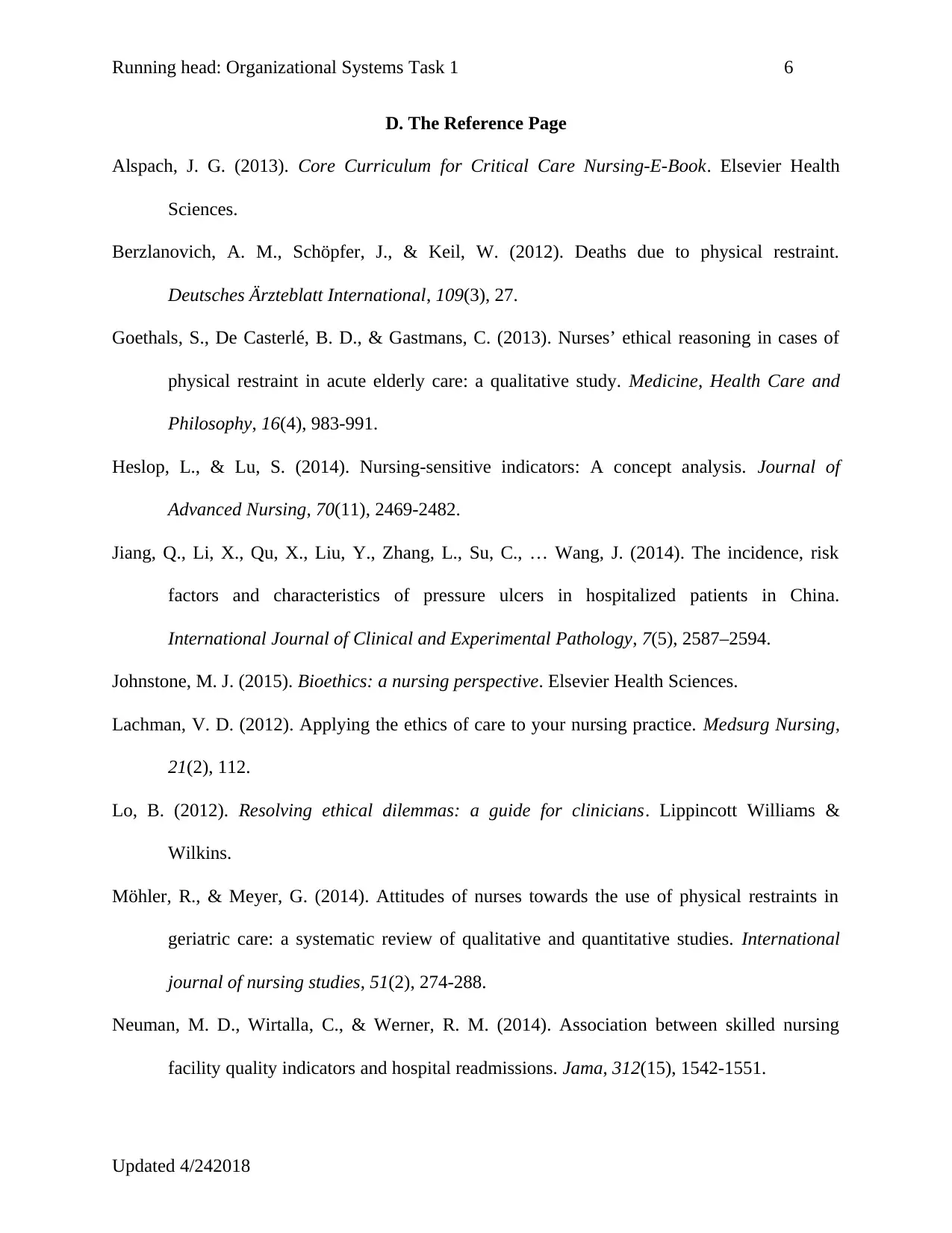
Running head: Organizational Systems Task 1 6
D. The Reference Page
Alspach, J. G. (2013). Core Curriculum for Critical Care Nursing-E-Book. Elsevier Health
Sciences.
Berzlanovich, A. M., Schöpfer, J., & Keil, W. (2012). Deaths due to physical restraint.
Deutsches Ärzteblatt International, 109(3), 27.
Goethals, S., De Casterlé, B. D., & Gastmans, C. (2013). Nurses’ ethical reasoning in cases of
physical restraint in acute elderly care: a qualitative study. Medicine, Health Care and
Philosophy, 16(4), 983-991.
Heslop, L., & Lu, S. (2014). Nursing‐sensitive indicators: A concept analysis. Journal of
Advanced Nursing, 70(11), 2469-2482.
Jiang, Q., Li, X., Qu, X., Liu, Y., Zhang, L., Su, C., … Wang, J. (2014). The incidence, risk
factors and characteristics of pressure ulcers in hospitalized patients in China.
International Journal of Clinical and Experimental Pathology, 7(5), 2587–2594.
Johnstone, M. J. (2015). Bioethics: a nursing perspective. Elsevier Health Sciences.
Lachman, V. D. (2012). Applying the ethics of care to your nursing practice. Medsurg Nursing,
21(2), 112.
Lo, B. (2012). Resolving ethical dilemmas: a guide for clinicians. Lippincott Williams &
Wilkins.
Möhler, R., & Meyer, G. (2014). Attitudes of nurses towards the use of physical restraints in
geriatric care: a systematic review of qualitative and quantitative studies. International
journal of nursing studies, 51(2), 274-288.
Neuman, M. D., Wirtalla, C., & Werner, R. M. (2014). Association between skilled nursing
facility quality indicators and hospital readmissions. Jama, 312(15), 1542-1551.
Updated 4/242018
D. The Reference Page
Alspach, J. G. (2013). Core Curriculum for Critical Care Nursing-E-Book. Elsevier Health
Sciences.
Berzlanovich, A. M., Schöpfer, J., & Keil, W. (2012). Deaths due to physical restraint.
Deutsches Ärzteblatt International, 109(3), 27.
Goethals, S., De Casterlé, B. D., & Gastmans, C. (2013). Nurses’ ethical reasoning in cases of
physical restraint in acute elderly care: a qualitative study. Medicine, Health Care and
Philosophy, 16(4), 983-991.
Heslop, L., & Lu, S. (2014). Nursing‐sensitive indicators: A concept analysis. Journal of
Advanced Nursing, 70(11), 2469-2482.
Jiang, Q., Li, X., Qu, X., Liu, Y., Zhang, L., Su, C., … Wang, J. (2014). The incidence, risk
factors and characteristics of pressure ulcers in hospitalized patients in China.
International Journal of Clinical and Experimental Pathology, 7(5), 2587–2594.
Johnstone, M. J. (2015). Bioethics: a nursing perspective. Elsevier Health Sciences.
Lachman, V. D. (2012). Applying the ethics of care to your nursing practice. Medsurg Nursing,
21(2), 112.
Lo, B. (2012). Resolving ethical dilemmas: a guide for clinicians. Lippincott Williams &
Wilkins.
Möhler, R., & Meyer, G. (2014). Attitudes of nurses towards the use of physical restraints in
geriatric care: a systematic review of qualitative and quantitative studies. International
journal of nursing studies, 51(2), 274-288.
Neuman, M. D., Wirtalla, C., & Werner, R. M. (2014). Association between skilled nursing
facility quality indicators and hospital readmissions. Jama, 312(15), 1542-1551.
Updated 4/242018
⊘ This is a preview!⊘
Do you want full access?
Subscribe today to unlock all pages.

Trusted by 1+ million students worldwide
1 out of 6
Related Documents
Your All-in-One AI-Powered Toolkit for Academic Success.
+13062052269
info@desklib.com
Available 24*7 on WhatsApp / Email
![[object Object]](/_next/static/media/star-bottom.7253800d.svg)
Unlock your academic potential
Copyright © 2020–2025 A2Z Services. All Rights Reserved. Developed and managed by ZUCOL.



